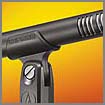 When a Production Sound Mixer eyeballs a scene, we strategize how we are going to capture all of the ensuing dialogue. In our head, there is a basic game plan to follow as we evaluate the blocking of the shot. This "Hierarchy of Microphone Techniques" consists of the following:
When a Production Sound Mixer eyeballs a scene, we strategize how we are going to capture all of the ensuing dialogue. In our head, there is a basic game plan to follow as we evaluate the blocking of the shot. This "Hierarchy of Microphone Techniques" consists of the following:
- Overhead boom
- Boom from underneath
- Boom mics as plant mics
- Lavalier mics as plant mics
- Lavalier mics as body mics
- Lavalier mics, wireless
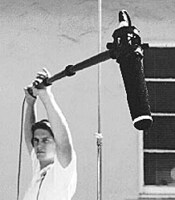 Overhead miking from a fishpole (or studio boom) is the most favored technique for film/video production and is the best choice most of the time.
Overhead miking from a fishpole (or studio boom) is the most favored technique for film/video production and is the best choice most of the time.
Using a boom mic yields realistic perspective; and a natural blend of dialogue and sound effects (footsteps, hand prop noise, etc.) In contrast, body-worn lavaliers only provide a constant perspective (close-up sound) and may not pick up the other sound textures in the scene.
Another advantage of overhead shotgun miking is that it is much easier to capture dialogue from multiple actors in the scene. Two-shots, three-shots, no problem. When I used to mix episodes from a police drama, it was not uncommon for the camera to pan across a squad room full of officers. But with just one (sometimes two) boom mics, we could cover over twenty cast members!
The operational word here is "overhead." Why?
There is a tendency for filmmakers to rely too heavily on their camera mounted shotgun mics rather than separately mounted boom mics. Obviously, having a microphone on the camera is more convenient. But our objective in the field is not convenience, but obtaining the highest quality sound possible!
Think of your shotgun microphone as a telephoto camera lens. A long lens will isolate and magnify a distant subject, but at the same time it will compress the perceived distance between subject and background. Everything appears to be closer together than they physically are.
The same sort of spatial compression takes place with microphones. The voice of the subject will sound closer, but any noise in the background will also be magnified.
Therefore, the key to isolating voice without background noise is to create a line of sight with the microphone that sees the voice but does not see the background!
To put this in cowboy talk, aim the mic from ABOVE the subject so that the mic points DOWNWARD. The line of sight reaches from the front of the mic, to the mouth, and then towards the ground. Background noise and ambiance will strike the sides of the microphone (which is the maximum rejection angle) rather than striking the mic along its most sensitive front axis.
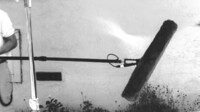 In the event that it is impossible to mike from above, the next best option is to mike from below, so that the line of sight terminates with sky. Miking upwards tends to emphasize bass a bit more, since the mic is seeing more of the chest cavity along with hearing more bass reflections from the ground.
In the event that it is impossible to mike from above, the next best option is to mike from below, so that the line of sight terminates with sky. Miking upwards tends to emphasize bass a bit more, since the mic is seeing more of the chest cavity along with hearing more bass reflections from the ground.
Be careful, as many camera operators are not as accustomed to maintaining a strict lower frame line as they are at watching their headroom, so the mic tends to pop into the shot more frequently.
Another important consideration when booming is not just the angle of the mic but the distance. Shotgun mics are not designed to be used (for broadcast quality sound) at much more than a few feet. One of the great advantages of using the mic on a fishpole, as opposed to being attached atop a camera, is that the mic can be brought close to the subject even when the camera isn't.
I often tell novice boom operators that they aren't doing their job properly if the camera operator fails to complain that the mic is in the frame (during rehearsal). Every inch closer that the mic can be to the subject will improve the quality of the sound. Never fly the mic higher than it absolutely needs to be if you want to control echo and background noise. Several inches to a foot over the top of talent's head is ideal; up to a few feet overhead is okay depending on the situation.
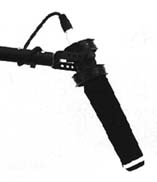 Place a thin strip of white tape on the tip of your boom mic's windscreen to make it obvious in the camera viewfinder. Better for the operator to notice it on the set than for the editor to discover it lurking in the frame during screenings! To achieve the closest mic placement, always begin with the mic clearly visible in the frame, and then move it outward gradually until it clears the viewfinder. Had you started with the mic placed way out of frame, and gradually moved closer -- the camera operator would probably have panicked and instructed you to stop way far above the frameline.
Place a thin strip of white tape on the tip of your boom mic's windscreen to make it obvious in the camera viewfinder. Better for the operator to notice it on the set than for the editor to discover it lurking in the frame during screenings! To achieve the closest mic placement, always begin with the mic clearly visible in the frame, and then move it outward gradually until it clears the viewfinder. Had you started with the mic placed way out of frame, and gradually moved closer -- the camera operator would probably have panicked and instructed you to stop way far above the frameline.
Some camera operators confuse width with height. A wide-angle lens means wide from left to right; it doesn't mean that they have to reveal several feet of air above the talent's head. A simple tilt-down of the lens will correct excessive headroom in the composition when using a wide angle lens!
Learn to recognize and take advantage of the on-axis (live) and off-axis (deader) angles of your mics. Most shotgun mics are very much on-axis at the front (say, twelve o'clock), and taper off towards the back (six o'clock). But at exactly six o'clock, there is an increase of sensitivity! In other words, the back of the mic does not offer the most rejection to background noise. The most rejection occurs around four o'clock and eight o'clock respectively.
So to decrease a source of noise, you would not want the mic facing directly away from it, as that would only serve to put the noise at the live spot in the back. Instead, angle the mic so that the noise source strikes slightly to the side and rear.
When deploying your mic overhead, keep these angles in mind. Often it is better to compromise the angle of the voice (slightly) in order to keep heavy background noise to a minimum. Any angle of the mic should be consistent with the source of the worst noise. For instance, a person talking on the sidewalk would put the mic overhead, but cheated towards the buildings and away from traffic -- even if the camera changes shot angles.
Similarly, a subject walking along the edge of the surf on a beach should have the mic facing inland, not out towards the noisy surf.
Another important factor to pay attention to is "perspective". The distance between microphone and subject should agree with the distance to the screen or camera. In a long shot, it is natural for the voice to sound more distant and for there to be a greater presence of ambiance. Close-up angles should consist of more voice and less background.
However, angle of motion is very important. A person walking away from the camera should not be walking towards the microphone, or vice versa! Novice boom operators are notorious for perching themselves in a safe spot out of the frame that places the mic in a position not consistent with the direction of travel relative to the lens.
A person with their back to camera should not be facing the mic. A person walking up to the camera should not be walking away from the mic.
To balance a strong voice against a weak voice, use your mic angle and placement rather than riding gain (volume) on your mixer/recorder. Let the strong voice strike the mic slightly off-axis and/or from a little more distance than the softer speaking actor. This will balance the relative volume of both people without having the background noise continually changing during the shot.
Now let's examine the types of microphones we have to chose from.
Microphones can be defined by two sets of parameters: sensitivity and pattern.
In terms of sensitivity, there are three main categories that a microphone can fall into.
![]() Dynamic: Think of a dynamic microphone as a manual typewriter. The harder that your finger hits the key, the stronger the imprint. With a dynamic mic, the pressure of the sound waves moving the diaphragm actually generates electrical current (which is what the sound signal is). Dynamic mics are extremely rugged and do not require any form of battery powering. They are relatively insensitive to background noise (or feedback) and are commonly used as handheld performance mics and reporter’s mics.
Dynamic: Think of a dynamic microphone as a manual typewriter. The harder that your finger hits the key, the stronger the imprint. With a dynamic mic, the pressure of the sound waves moving the diaphragm actually generates electrical current (which is what the sound signal is). Dynamic mics are extremely rugged and do not require any form of battery powering. They are relatively insensitive to background noise (or feedback) and are commonly used as handheld performance mics and reporter’s mics.
A dynamic mic used close to the mouth will reject all but the loudest background noise, making them ideal for stand-up reporting (where the mic can be seen on camera) or narration recording (to eliminate as much background as possible). The example shown here is the Electro-Voice RE50, a longtime favorite of news reporters.
Dynamic mics tend to naturally compress loud noises, making them a good choice for recording explosive and crashing sound effects. A loud sound effect, unless carefully recorded, will tend to be "blown" right off of the recording tape, which is why real gunshots that leave your ears ringing only sound like dull pops on a videotape.
The downside to dynamic microphones is that they have very poor reach in terms of distance when it comes to dialogue. They are pretty much useless on a boom or fishpole.
Here is a tip: When filming an actor who is pretending to be a performer and will be seen using a handheld mic, it is much safer to consider the hand mic as merely a stage prop and to mic the actor with a boom or lavalier. Actors in those situations tend to gesture wildly with the mic, making your chances of getting good dialogue quite slim.
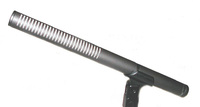 The next most sensitive group of microphones are the electret condensers. Electret condenser microphones are like electric typewriters. These microphones operate off of a nominal voltage (usually 1.5 volts) which is derived from an internal battery such as an AA or button battery. The voltage that creates the audio signal comes from the battery (as opposed to being generated magnetically as in the case of dynamics); the relative sound levels control the capacitance, releasing voltage according to what the mic hears. Almost think of it like a meter that measures the sound, and releases a signal accordingly.
The next most sensitive group of microphones are the electret condensers. Electret condenser microphones are like electric typewriters. These microphones operate off of a nominal voltage (usually 1.5 volts) which is derived from an internal battery such as an AA or button battery. The voltage that creates the audio signal comes from the battery (as opposed to being generated magnetically as in the case of dynamics); the relative sound levels control the capacitance, releasing voltage according to what the mic hears. Almost think of it like a meter that measures the sound, and releases a signal accordingly.
Electret condenser mics offer much more sensitivity (range) than dynamics, and include what is commonly referred to as "ENG" grade shotgun mics as well as most lavaliers.
Examples of electret condenser shotgun mics include the Audio Technica AT897 (pictured), AT8015; and the Sennheiser K6/ME66 (or the older K3U/ME80). Lavaliers include the Sony ECM44/55/66/77, the Tram TR50, the Sennheiser MKE 2, and the Audio Technica AT803b , MT830R, AT899.
The third group of professional microphones are the true condenser type. Think of electronic word processors. Condenser shotgun mics are the most sensitive and offer the greatest working range for Production.
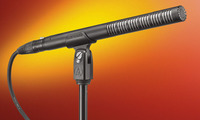 Condenser mics require external powering such as 12volt T or 48volt Phantom, which can be supplied by an accessory battery power supply plugged in line between the microphone and the mixer/recorder. Most mixers, recorders, and camcorders offer built-in mic powering.
Condenser mics require external powering such as 12volt T or 48volt Phantom, which can be supplied by an accessory battery power supply plugged in line between the microphone and the mixer/recorder. Most mixers, recorders, and camcorders offer built-in mic powering.
Examples of condenser shotguns include the Audio Technica BP4073 (shown here) and BP4071; and the Sennheiser MKH416, MKH60, and MKH70.
A note here on microphone powering, which is an area very confusing to many people. As stated before, dynamic mics do not require any external powering, and plug directly into the MIC INPUT of a mixer/recorder. Electret condenser mics are self-powered (by an internal battery) and also plug directly into the MIC INPUT. Condenser mics require external powering, which can be a battery supply (such as the Denecke PS1A, shown below) located anywhere along the mic cable path.
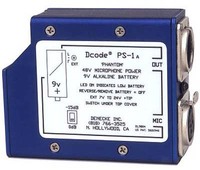 For instance, the mic connects to a regular XLR cable, that cable plugs into the power supply, and then another short cable connects the power supply to the MIC INPUT.
For instance, the mic connects to a regular XLR cable, that cable plugs into the power supply, and then another short cable connects the power supply to the MIC INPUT.
In all of the above cases, if the mixer/recorder offers the option of mic powering, that option IS NOT USED. The correct MIC INPUT setting would read "dynamic."
Sometimes, we can power a CONDENSER mic directly from the mixer or recorder. In that case, the external battery supply is not used at all, and the mic plugs directly in. A switch near the MIC INPUT should be switched to "48 Phantom" or "T" or "A-B", depending.
Condenser mics come in two basic varieties: 12 volt T or 48 volt Phantom. The designations "12 volt T" and "12 volt A-B" mean the exact same thing, by the way. The difference between T powering and Phantom is significant.
T powering involves sending 12 volts up the mic line along pins 2 and 3 of the mic cable. Traditionally, pin 2 is PLUS and pin 3 is MINUS. Pin 1 is simply used for shield and ground.
 Phantom Power uses all three pins to send 9 to 48 volts of powering up to the mic. Both pins 2 and 3 are PLUS, and pin 1 is MINUS. Some mics are advertised as being able to function at 9 or 12 volts Phantom. However, all of the premium condenser mics that I have encountered prefer and are rated for 48 volt Phantom.
Phantom Power uses all three pins to send 9 to 48 volts of powering up to the mic. Both pins 2 and 3 are PLUS, and pin 1 is MINUS. Some mics are advertised as being able to function at 9 or 12 volts Phantom. However, all of the premium condenser mics that I have encountered prefer and are rated for 48 volt Phantom.
In theory, Phantom power should not interfere with the operation of dynamic mics, since the voltage is balanced equally across pins 2 and 3 (which conduct the audio signal). Experience dictates otherwise. Although most dynamic handhelds are not affected, the same is not true of all electronic based mics, such as some wireless.
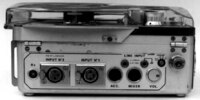 There is one more complication to be aware of, namely the term "red dot". In the early days of filmmaking ("b.bc." or before Beta Cam), people only used Nagra recorders for audio. Because Nagras are positive ground, they were set up with T-powering that was pin 3 PLUS and pin 2 MINUS. To correct for this, most mics intended for film use were modified to match this reversed standard, and were designated as "red dot" mics because a red dot was usually (but not always) engraved on the side.
There is one more complication to be aware of, namely the term "red dot". In the early days of filmmaking ("b.bc." or before Beta Cam), people only used Nagra recorders for audio. Because Nagras are positive ground, they were set up with T-powering that was pin 3 PLUS and pin 2 MINUS. To correct for this, most mics intended for film use were modified to match this reversed standard, and were designated as "red dot" mics because a red dot was usually (but not always) engraved on the side.
Today, one will encounter quite a number of Sennheiser 415/416/815/816 shotgun mics that are "red dot" polarity. To make them work with non red-dot power supplies, simply use a reversing cable between the mic and the power supply. A reversing cable is merely a short mic cable that has the leads switched in one connector, so that pin 2 goes to 3, 3 goes to 2, and 1 remains connected to 1.
Now, onto the other way we classify mics: by pickup pattern.
The other parameter by which we classify shotgun mics is by their pickup pattern.
Omnidirectional refers to hearing equally well in all directions. Most lavaliers are omni, which is good since they could end up being worn in different places and at different angles in order to accommodate clothing styles. Omni mics are also preferred for handheld interviews, since this allows for the unexpected overlapping of dialogue between interviewer and subject.
Cardioid pattern literally means heart shaped, and refers to microphones that are more directional from the front.
Hypercardioid or supercardioid are considerably directional. This group includes what are known as "short shotguns" such as the Audio Technica BP4073 and the Sennheiser MKH416/60.
Ultra-directional means extremely directional, such as full or long shotgun mics. Examples include the Audio Technica BP4071 and the Sennheiser MKH816/70.
So which mic to use?
The rule of thumb is that the more directional the microphone, the more it will emphasize echo in a small room. Therefore, reach the best compromise between the reach you need and the mellowness you would like to hear.
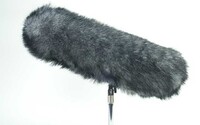 Long shotguns work the best for most exterior shots, since theses mics are characterized by long reach and very narrow pick-up. The narrow field of view helps to control background noise if the mic is deployed overhead. The greater range helps because exterior shots are very often much wider than interior frames, since there is more interesting stuff to look at or action to cover. Long shotguns can be successfully deployed up to 8 or 9 feet overhead, depending on the situation.
Long shotguns work the best for most exterior shots, since theses mics are characterized by long reach and very narrow pick-up. The narrow field of view helps to control background noise if the mic is deployed overhead. The greater range helps because exterior shots are very often much wider than interior frames, since there is more interesting stuff to look at or action to cover. Long shotguns can be successfully deployed up to 8 or 9 feet overhead, depending on the situation.
Always used a blimp windscreen on your long shotguns to guard against wind noise. I find that using a thin foam windscreen inside of the blimp (but still leaving some airspace) gives almost twice the protection. On the very sensitive condenser mics, a furry windsock will help to disperse the wind and diffuse it upon impact.
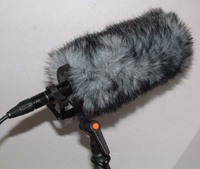 The new K-Tek Fuzzy windscreen is a mini-zeppelin with integral furry covering that fits over the mic like a foam windscreen, but offers adequate protection against light wind and is considerably less expensive than a full zeppelin rig.
The new K-Tek Fuzzy windscreen is a mini-zeppelin with integral furry covering that fits over the mic like a foam windscreen, but offers adequate protection against light wind and is considerably less expensive than a full zeppelin rig.
To guard against rain, use lots of ScotchGuard spray. Extreme rain (or fire fighting) would call for a thin condom over the mic itself, as well as a rainhat over the blimp made from what we call "hogs hair" or "rubberized hair". Hogs hair is a thicket type material that will break up the raindrops and prevent the pitter patter sound of them striking the windscreen, roof of a vehicle, or roof of a recording stage.
Long shotguns may also be used on some interiors, providing that the room or sound stage is very large and free of echo. They offer the advantage of increased overhead range and headroom on wide shots. Their disadvantage on interiors is: 1) they are physically longer and may bump a low ceiling; 2) they must be precisely cued or aimed because of their narrow pattern (to cover two actors requires a very good boom operator); and 3) long shotguns will exaggerate room echo.
Prime examples of high quality, condenser long shotguns include the Audio Technica BP4071 and the Sennheiser MKH70. There are still a lot of the older MKH816's floating around. For those on a smaller budget, the Audio Technica AT8015 and the Sennheiser K6/ME67 are ENG quality shotguns that can operate from an internal AA battery.
Interior locations are usually better off being miked with a short shotgun. The short shotgun features a slightly wider pattern and slightly less range, but does not exaggerate the room echo as much. The wider pattern and physically shorter length of theses mics facilitates use with lower ceilings, especially when it comes to covering multiple actors. Condenser short shotguns can be deployed indoors up to 5 feet above the actors (though 2 to 3 feet is better).
Today's favorite short shotgun condenser mics include the Audio Technica BP4073 and the Sennheiser MKH60.
In the choices of electret condenser short shotguns, there are the Audio Technica AT897,the AT8035 and the Sennheiser K6/ME66. Neither mic offers the range (4 to 6 feet) of their big brother condensers, but at shorter distances (up to 3 1/2 feet) they sound very good on the soundtrack. The main advantages of these ENG shotguns are price and ruggedness. Both mics are the standards of the news gathering industry.
Indoors, all short shotgun mics should always be used with a foam windscreen. Out of doors, a blimp windscreen or half-blimp such as the K-Tek Fuzzy Slip-On or Rycote Softie should be utilized.
In a pinch, simply wrap a few layers of cheesecloth over the foam windscreen, and then cover in a tube-style sweat sock. It works.
Any shotgun mic should always be used in a good shockmount to eliminate handling noise and vibration. The industry standards for short shotguns are the Audio Technica AT8415 universal shockmount (the tic tac toe rubber band mount) and the efficient K-Tek K-SM.
Blimp windscreens require their own brand of pistol grip shockmounts, which are usually purchased in conjunction with the windscreen system. These mounts are intended to be used with or without the windscreen, so there is no need to purchase a separate shockmount if you have a blimp system.
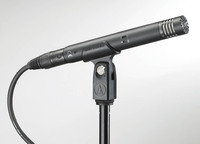 In addition to the long shotgun and short shotgun, Hollywood has begun using a third type of microphone in its quest for perfect dialogue. Some condenser cardioid microphones have become popular for their ability to reduce or even eliminate echo in a small room or set!
In addition to the long shotgun and short shotgun, Hollywood has begun using a third type of microphone in its quest for perfect dialogue. Some condenser cardioid microphones have become popular for their ability to reduce or even eliminate echo in a small room or set!
These mics yield a very rich voice track, are are favored for close-ups and medium close-ups where the overhead mic will not be more than two feet overhead. Examples include the Audio Technica AT4051b (pictured), the Sennheiser MKH40, and the Schoeps CMC4/MK41.
One last point. Make sure that the boom operator can HEAR the soundtrack! In order to properly position a mic both in terms of distance and angle, the boomperson must be able to listen to what is being picked up. Provide a headphone feed either via a wireless (assistive listening) rig or with a long headphone extension cable.
On professional sets, we uitilize a special mic cable (known as a "duplex cable" or "boom cable") that combines an XLR microphone cable with a headphone cable in one housing. This cable conveys the audio signal from the mic to the mixing board while sending a headphone feed back to the boomperson.
Because there are often multiple mics in use on a set (boom, plant, lavalier, wireless) -- the boom operator should be monitoring the entire mix (not only the boom mic) so as to be aware of any phasing problems that would be created by two mics picking up the same actor at the same time.